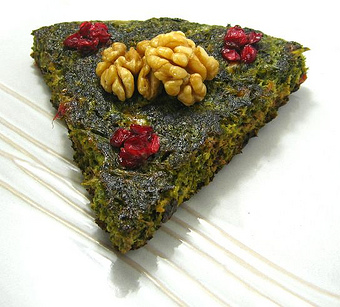Facts About Kuku
Kuku, also known as kookoo, is a delightful Iranian dish that combines whipped eggs with a variety of ingredients. Comparable to a frittata, quiche, eggah, or an open-faced omelette, kuku has its own unique characteristics, particularly in the ratio of eggs to other ingredients and the cooking time. It can be enjoyed either hot or cold, making it versatile enough to serve as an appetizer, side dish, or even the main course. It’s typically accompanied by bread, yogurt, or salad. In northern Iran, it is often eaten as a light midday meal with rice or bread.
Historical Iranian cookbooks mention kuku made with coriander, and during the Safavid and Qajar periods, it was commonly recognized as a side dish. One of the most popular variations is herb kuku (kuku sabzi), which is typically enjoyed during Nowruz (the Persian New Year) and Easter. Traditionally, kuku is made by frying the ingredients over low heat, but in recent times, baking has become a more popular method.
There are several delightful variations of kuku, including:
1. Herb Kuku (Kuku Sabzi): This is the most common type, made with eggs, leeks, parsley, and occasionally garlic. It is especially popular during Nowruz.
2. Potato Kuku (Kuku Sibzamini): Similar to a Spanish omelette, this version includes eggs, potatoes, and other tasty ingredients.
3. Eggplant Kuku (Kuku-ye Bādenjān): This variation features mashed eggplant, eggs, parsley, walnuts, onions, and barberries.
4. Roe Kuku (Ašbal Kuku): A unique variation from the Gilaki region that includes roe (caviar).
5. Yogurt Kuku (Kuku-ye Mäst): This interesting twist incorporates yogurt into the recipe.

 Armenia
Armenia